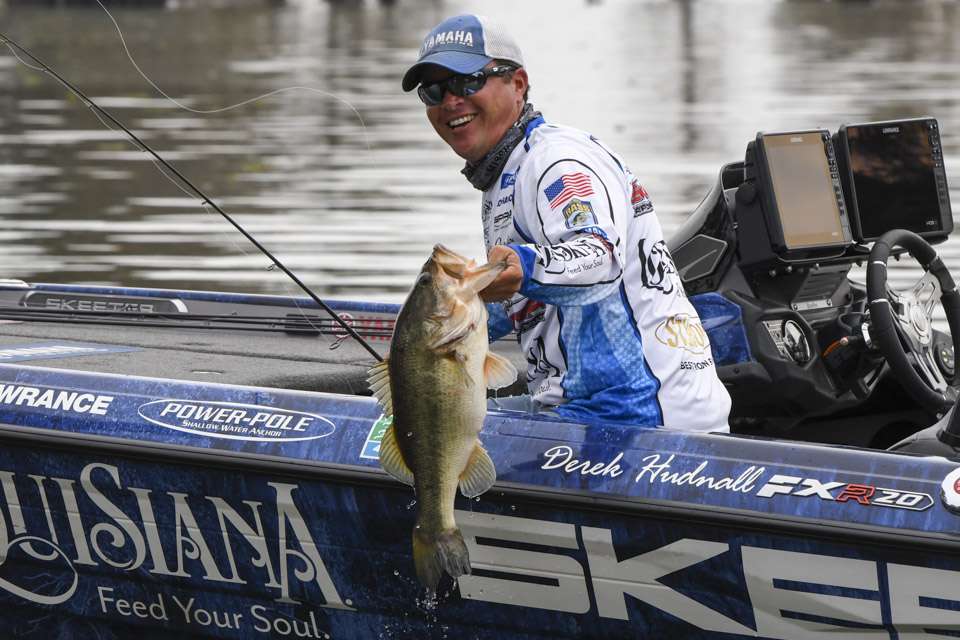
The fall transition is a tough time and big bites have made a big difference for several anglers fishing semi-final Saturday at the Bassmaster Elite at Santee Cooper Lakes brought to you by the United States Marine Corps.
Among them, Jeff Gustafson rose from 34th on Day 1 to fourth yesterday by anchoring Day 2’s heaviest sack — 22-7 — with a 9-pound, 7-ounce beast that’s currently the event’s biggest bass.
“That fish changed my whole tournament,” Gustafson said. “When I caught it, I had three fish — two little ones and a 4-pounder. As soon as I got it in my hand, I said ‘I’m getting a check, I’m making the top-40, I’m not bombing, life’s good’.”
Meanwhile, a 6-5 helped Brandon Palaniuk take over the tournament lead on Day 2. Also, Derek Hudnall weighed a 7-12 and move into third place; veterans Clark Wendlandt and Bernie Schultz had kickers of 5-15 and 5-10, respectively; and Frank Talley, who claimed his first Elite win last week on Lake Guntersville, started yesterday with a 5-10 and entered Day 3 in ninth place.
“Anytime you’re on a really tough bite, when you’re not getting many bites to begin with and the fish are running mediocre to small, a big bite separates you,” said Schultz, who improved from 41st to 13th yesterday. “I lost one on Day 1 that was as big as my Day-2 kicker.
“I’m thankful that I caught a big one and it really made the difference in (reaching Semi-Final Saturday), but it makes you think about the one you lost and that’s kind of aggravating. I had an opportunity to maybe be right up at the top.”
Potential and Performance
Stocked with hefty Florida-strain largemouth, this two-lake system comprising Lake Marion and Lake Moultrie and their linking Diversion Canal, is a legitimate giant factory. Habitat abounds and there’s plenty of water to cover, but this time of year defines feast-or-famine.
Luke Palmer, who starts the day in seventh said: “It probably looks good on Bassmaster Live, but it’s a grind. Most guys are only getting 7-8 bites a day.”
That means you really gotta convert those infrequent big-fish opportunities when they arise.
Carl Jocumsen, who starts today in second place, lead Day 1 with the event’s heaviest bag — a limit of 25 pounds, 8 ounces that included a 6-15 and a 6-3. Day 2 offered him a shot at an early kicker, but the big fish shook his ChatterBait.
Nevertheless, Jocumsen remains optimistic: “Any cast could be a 10-pounder.”
Schultz, who competed in the last Elite event on Santee Cooper in 2006, adds this: “In Florida, if you’re around a lot of fish, you’re going to get a big bite eventually, because (Florida-strain fish) don’t school by year class like northern largemouth, they mix. You could catch 30 1 1/2-pound fish and all of a sudden catch a 10-pounder.
“That’s the case this week on Santee Cooper; I’m catching a lot of 1 1/2 to 2 1/2-pound fish and then you get a big bite. I don’t leave fish that are biting and it really paid off. I slowed down and really got the bite I needed.”
Where They Live
What’s interesting is that, while that big bite could potentially happen anywhere, anglers have shared examples that support the notion of bigger fish favoring particular areas. Palaniuk said he boated his 6-5 about 30 feet from where he’d caught a 7-9 on Day 1. The same area gave up a big bite in practice.
Hudnall described a zero-to-hero moment in which he lost a 5-pounder on his previous cast to the same tree that produced his 7-12. Sending his wacky-rigged Missile Baits 48 back to the zone was one of his best decisions of the event.
“The bites are few and far between, but I’m fishing for big ones,” Hudnall said. “More fish like that are possible where I’m fishing if I can make the right casts.”
Hudnall attributes his potential more to his area, than specific spots. He’s fishing what he calls “a jungle” — dense cypress swamp very similar to what he fishes in his Southern Louisiana home waters. A few subtle drains keep the water moving and that promotes clarity, oxygenation and forage abundance.
“I knew when I saw this spot that there would be a population of fish in there,” Hudnall said. “I lost what may have been my personal best in there during practice, so I immediately knew there were big ones in there. I’m fishing very methodically and I have to treat every tree like there’s a fish on it.”
What to Expect
Today’s weather complexion — more clouds and wind — will likely prompt a few tactical changes. The punch bite that produced several big catches the past two days won’t necessarily go away, but it’s generally best when sunny skies position fish deeper into the shady cover. (Same for flipping cypress trees.) That being said, it’s still hot in South Carolina, and those mats are cool and cozy.
Another key factor: dimmer skies and increasing wind bodes well for reaction baits, so we could see more topwater, spinnerbait and swimbait efforts today. At some point, we may see Palaniuk and/or Jocumsen break out the glide baits — a big-fish technique with which they’re both highly skilled.
Whatever anglers throw, those big bites will present day-making opportunities, so capitalizing on each one will be crucial.

